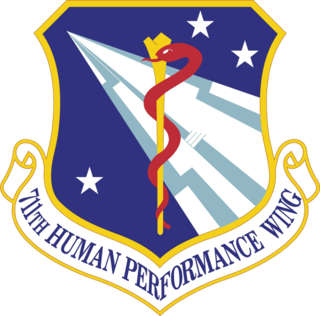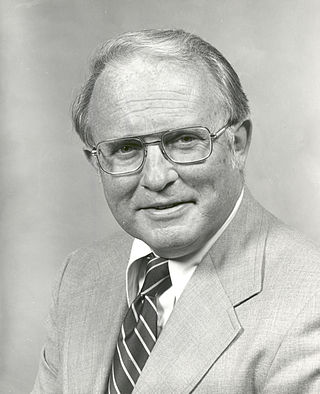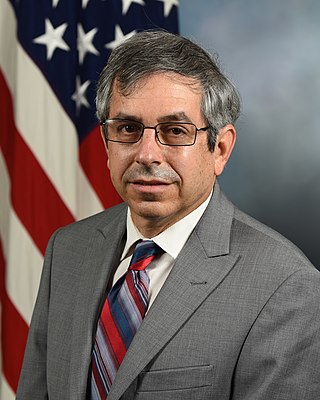
The Air Force Research Laboratory (AFRL) is a scientific research and development detachment of the United States Air Force Materiel Command dedicated to leading the discovery, development, and integration of direct-energy based aerospace warfighting technologies, planning and executing the Air Force science and technology program, and providing warfighting capabilities to United States air, space, and cyberspace forces. It controls the entire Air Force science and technology research budget which was $2.4 billion in 2006.
Ivan Alexander Getting was an American physicist and electrical engineer, credited with the development of the Global Positioning System (GPS). He was the co-leader of the research group which developed the SCR-584, an automatic microwave tracking fire-control system, which enabled M9 Gun Director directed anti-aircraft guns to destroy a significant percentage of the German V-1 flying bombs launched against London late in the Second World War.
Jerome Pearson was an American engineer and space scientist best known for his work on space elevators, including a lunar space elevator. He was president of STAR, Inc., and has developed aircraft and spacecraft technology for the United States Air Force, DARPA, and NASA. He held several patents and was the author of nearly 100 publications in aircraft, spacecraft, electrodynamic tethers, SETI, and global climate control.

The 711th Human Performance Wing is a wing of the United States Air Force based at Wright-Patterson Air Force Base near Dayton, Ohio.

Alan Mathieson Lovelace was the Deputy Administrator of NASA from July 2, 1976, to July 10, 1981. He filled in as acting Administrator twice: once during the Jimmy Carter administration to fill the May 2 to June 20, 1977, vacancy left by the retirement of James C. Fletcher, and again during the start of Ronald Reagan's administration from January 21 to July 10, 1981, until Reagan's choice James M. Beggs was confirmed by Congress.
The Advanced Technical Intelligence Center for Human Capital Development (ATIC) is a university and industry-focused research, education, and training nonprofit corporation within the Dayton Region. It consolidates technical intelligence education and training in the DoD, national agencies, and civilian institutes and industry.
Frederick Stucky Billig was an American aerospace engineer who was a pioneer in the development of scramjet propulsion.

Ulfila Mark J. Lewis is a senior American aerospace and defense executive with special expertise in hypersonics. He is currently the Executive Director of the National Defense Industrial Association's Emerging Technologies Institute, following his role in the second half of 2020 as the acting US Deputy Under Secretary of Defense for Research and Engineering, and before that the Director of Defense Research and Engineering for Modernization. He was the Chief Scientist of the U.S. Air Force, Washington, D.C. from 2004 to 2008 and was the longest-serving Chief Scientist in Air Force history. He served as chief scientific adviser to the Chief of Staff and Secretary of the Air Force, and provided assessments on a wide range of scientific and technical issues affecting the Air Force mission. In this role he identified and analyzed technical issues and brought them to attention of Air Force leaders, and interacted with other Air Staff principals, operational commanders, combatant commands, acquisition, and science & technology communities to address cross-organizational technical issues and solutions. His primary areas of focus included energy, sustainment, long-range strike technologies, advanced propulsion systems, and workforce development.
The service-oriented computing environment (SORCER) is a distributed computing platform implemented in Java. It allows writing network-programs that operate on wrapped applications (services) to spread across the network. SORCER is often utilized in scenarios similar to those where grids are used in order to run parallel tasks.

Paul F. McManamon is an American scientist who is best known for his work in optics and photonics, as well as sensors, countermeasures, and directed energy.

Prahlada Rama Rao is an Indian missile scientist, former vice chancellor of Defence Institute of Advanced Technology and a former director of Defence Research and Development Laboratory, the largest of the Defence Research and Development Organization laboratories in India, known for his contributions to Indian space programme. He was honoured by the Government of India in 2015 with Padma Shri, the fourth highest Indian civilian award.
William J. Baldygo is an electrical engineer at U.S. Air Force Research Laboratory, Dayton, Ohio.
Jonathan P. How is a Canadian-American astrophysicist and aeronautical engineer currently the Richard Cockburn Maclaurin Professor at Massachusetts Institute of Technology. His current research focuses on technology systems engineering and space engineering.
The Generation Orbit X-60 was an air-launched single stage suborbital rocket vehicle produced by Generation Orbit.

Moriba Kemessia Jah CorrFRSE is an American space scientist and aerospace engineer who describes himself as a "space environmentalist", specializing in orbit determination and prediction, especially as related to space situational awareness and space traffic monitoring. He is currently an associate professor of Aerospace Engineering and Engineering Mechanics at the University of Texas at Austin. Jah previously worked as a spacecraft navigator at the NASA Jet Propulsion Laboratory, where he was a navigator for the Mars Global Surveyor, Mars Odyssey, Mars Express, Mars Exploration Rover, and his last mission was the Mars Reconnaissance Orbiter. He is a Fellow of the American Astronautical Society, the Air Force Research Laboratory, the International Association for the Advancement of Space Safety and, the Royal Astronomical Society. Jah was also selected into the 10th anniversary class of TED Fellows and was named a MacArthur Fellow in 2022. He also was selected into the AIAA class of Fellows and Honorary Fellows in the year of the 50th Anniversary of Apollo 11. The AIAA "confers the distinction of Fellow upon individuals in recognition of their notable and valuable contributions to the arts, sciences or technology of aeronautics and astronautics."

Allen F. Donovan was an American aerospace engineer and systems engineer who was involved in the development of the Atlas and Titan rocket families. He served as a consultant to the President's Science Advisory Committee from 1957 until 1978.

Subrata Roy is an Indian-born American inventor, educator, and scientist known for his work in plasma-based flow control and plasma-based self-sterilizing technology. He is a professor of Mechanical and Aerospace Engineering at the University of Florida and the founding director of the Applied Physics Research Group at the University of Florida.

William Neil McCasland is an astronautical engineer, retired United States Air Force major general, and former commander of Air Force Research Laboratory. He is currently the director of technology at Applied Technology Associates.

Khanh Dai Pham is a Vietnamese-born American aerospace engineer. He is noted for his work in statistical optimal control theory, game-theoretic operations research of military satellite communications, space control autonomy, and space domain awareness and the government leadership in innovation ecosystem and coalition of government agencies, small business and industry. He is a Fellow of the Air Force Research Laboratory (AFRL), the National Academy of Inventors (NAI), the Institution of Engineering and Technology (IET), the Society of Photo-Optical Instrumentation Engineers (SPIE), the Royal Aeronautical Society (RAeS), the International Association for the Advancement of Space Safety (IAASS), and the Royal Astronomical Society (RAS). He is not only a Fellow of the Institute of Electrical and Electronics Engineers (IEEE), the American Astronautical Society (AAS), and the Asia-Pacific Artificial Intelligence Association (AAIA) but also an Associate Fellow of the American Institute of Aeronautics and Astronautics (AIAA) and the Royal Institute of Navigation (RIN).

Michael Theodore Eismann is an American scientist and researcher working at the Air Force Research Laboratory. He is a former editor of Optical Engineering and a member of the NATO Sensors and Electronics Technology panel. In 2023, Eismann was elevated to fellow membership of the IEEE.












